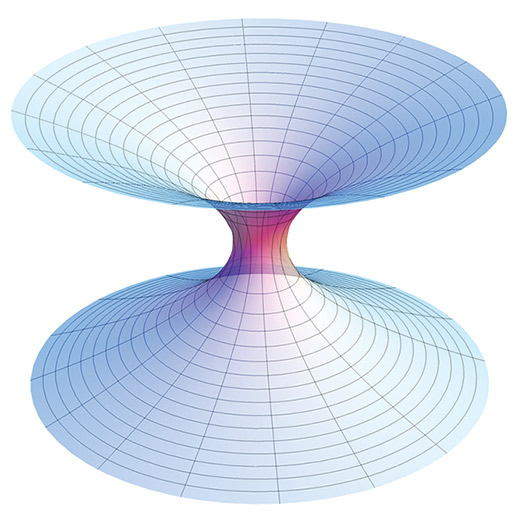Quantum entanglement is one of the more bizarre theories to come out of the study of quantum mechanics—so strange, in fact, that Albert Einstein famously referred to it as “spooky action at a distance.”

Essentially, entanglement involves two particles, each occupying multiple states at once, for example simultaneously spinning clockwise and counterclockwise. But neither has a definite state until one is measured, causing the other particle to instantly assume a corresponding state. The resulting correlations between the particles are preserved even if they reside on opposite ends of the universe.
But what enables particles to communicate instantaneously—seemingly faster than the speed of light—over such vast distances?
Now an MIT physicist looking at entanglement through the lens of string theory has proposed an answer: the creation of two entangled quarks—the building blocks of matter—simultaneously gives rise to a wormhole connecting the pair.
The theoretical results bolster the relatively new and exciting idea that the laws of gravity holding together the universe may not be fundamental but arise instead from quantum entanglement.
Julian Sonner, a senior postdoc in MIT’s Laboratory for Nuclear Science and Center for Theoretical Physics, has published his results in the journal Physical Review Letters.
To see what emerges from two entangled quarks, he first created a theoretical model of quarks based on the Schwinger effect—a concept in quantum theory that makes it possible to create particles out of nothing. Once extracted from a vacuum, these particles are considered entangled.
Sonner mapped the entangled quarks onto a four-dimensional space, considered a representation of space-time. In contrast, gravity is thought to exist in the next dimension, where, according to Einstein’s laws, it acts to “bend” and shape space-time.
To see what geometry may emerge in the fifth dimension from entangled quarks in the fourth, Sonner employed the string theory concept of holographic duality, used to derive a more complex dimension from the next-lowest dimension.
He found that what emerged was a wormhole connecting the two entangled quarks, implying that the creation of quarks simultaneously creates a wormhole. More fundamentally, he says, gravity itself may be a result of entanglement. What’s more, the universe’s geometry as described by classical gravity may be a consequence of entanglement—pairs of particles strung together by tunneling wormholes.
“It’s the most basic representation yet that we have where entanglement gives rise to some sort of geometry,” Sonner says. “What happens if some of this entanglement is lost, and what happens to the geometry? There are many roads that can be pursued.”
Keep Reading
Most Popular
Large language models can do jaw-dropping things. But nobody knows exactly why.
And that's a problem. Figuring it out is one of the biggest scientific puzzles of our time and a crucial step towards controlling more powerful future models.
How scientists traced a mysterious covid case back to six toilets
When wastewater surveillance turns into a hunt for a single infected individual, the ethics get tricky.
The problem with plug-in hybrids? Their drivers.
Plug-in hybrids are often sold as a transition to EVs, but new data from Europe shows we’re still underestimating the emissions they produce.
Stay connected
Get the latest updates from
MIT Technology Review
Discover special offers, top stories, upcoming events, and more.